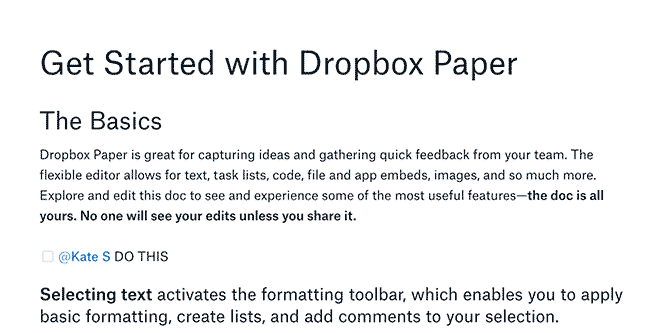
Other benefits of using Dropbox Paper include: And that's just one of its many benefits. For those who want the social aspects of collaboration, it integrates with Giphy and includes a good collection of emoticons and stickers.Dropbox Paper delivers a simplified way to create documents on the fly without much effort. To start the LaTeX editor, simply start a line with $$. For example, typing two brackets with a character space between them starts a to-do list. It has a simple but effective notation format for users that are keyboard- and text-driven. You can’t edit the embedded card, but any changes to the card from within Trello appear in the embedded card in real-time.Īn interesting dichotomy exists in the usability features that could drive adoption within an organization. The integration really just gives a way to track Trello status within a Paper doc. Trello integration applies just to cards, using the card’s link.

#DROPBOX PAPER FORMATTING FULL#
It provides enough visibility to do a quick scroll through the data and look at a full record. The Airtable integration embeds a small view of a data table in the document.
#DROPBOX PAPER FORMATTING FREE#
It integrates with Instagram, Unsplash (a site for sharing free stock photography and images), YouTube, Slideshare, Prezi and Speaker Deck.Ĭompanies that use Airtable or Trello can also integrate those applications with Dropbox Paper. As with the design example, the workspace can function not only as collaborative space but as a means to document the evolution of data analysis and algorithm design.ĭropboxPaper has a few integrations that could help marketing teams as well.
#DROPBOX PAPER FORMATTING CODE#
Teams that do a considerable amount of research and analysis should consider Dropbox Paper for its support of Lucidchart, LaTeX symbols, and the Python and R languages in the code editor. The aforementioned code editor also provides a means of documenting and sharing code snippets. As a best practice, the Dropbox Paper workspace can be a documentation tool for tracking design changes with an easy way to compare iterations of an idea in a single space. For example, IT and digital design teams that use Adobe XD, Figma, Framer, InVision or Marvel App for user interface design can drop content design ideas via a share link onto a Paper workspace for commenting.Īt a basic level, these embedded views of documents in other applications can provide a dashboard of files residing on other services. Like Onepgr, however, IT organizations can use Paper’s third-party app integration as a way to create tailored workspaces around particular use cases. While Dropbox Paper uses a “sheet of paper” metaphor similar to Onepgr’s, it differs from Onepgr’s real-time collaboration focus. All of this makes it appealing as a simple workspace for some IT teams or business users with technical skill sets. It includes a code editor and support for LaTeX symbols, the ability to embed content from the Dropbox enterprise content sharing and collaboration, and some third-party applications.

Paper’s simple feature set belies an ability to do some sophisticated content-based collaboration, however.

Think of it not as replacing broader team collaboration tools, but as a very focused, free tool that a particular set of users could get considerable value from. By including commenting, to-do lists, timeline task views and the ability to team members, it has enough team collaboration capabilities that it can be broadly applicable while not requiring users to learn too many new ways to work. At its core, it behaves like a mashup of a wiki and simple project management application. IT organizations can use Paper for their own needs as well as provide it to end user teams that need to stand up a simple workplace to quickly collaborate around content.ĭropbox Paper doesn’t try to do too much on its own, which makes it easy to use. For organizations that use Dropbox, the recently revamped Dropbox Paper application gives teams a way to manage collaborative processes within a “sheet of paper” metaphor.


 0 kommentar(er)
0 kommentar(er)
